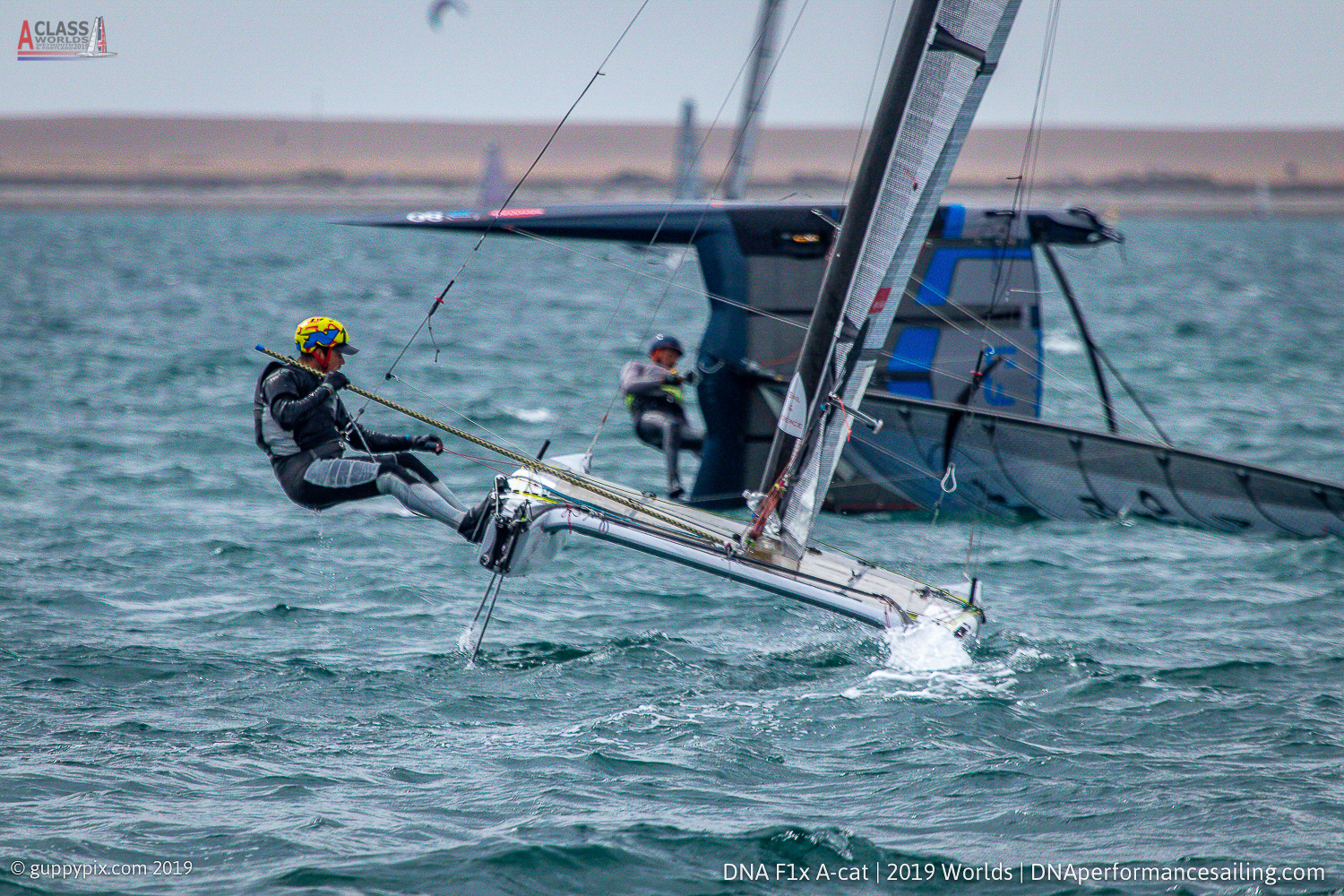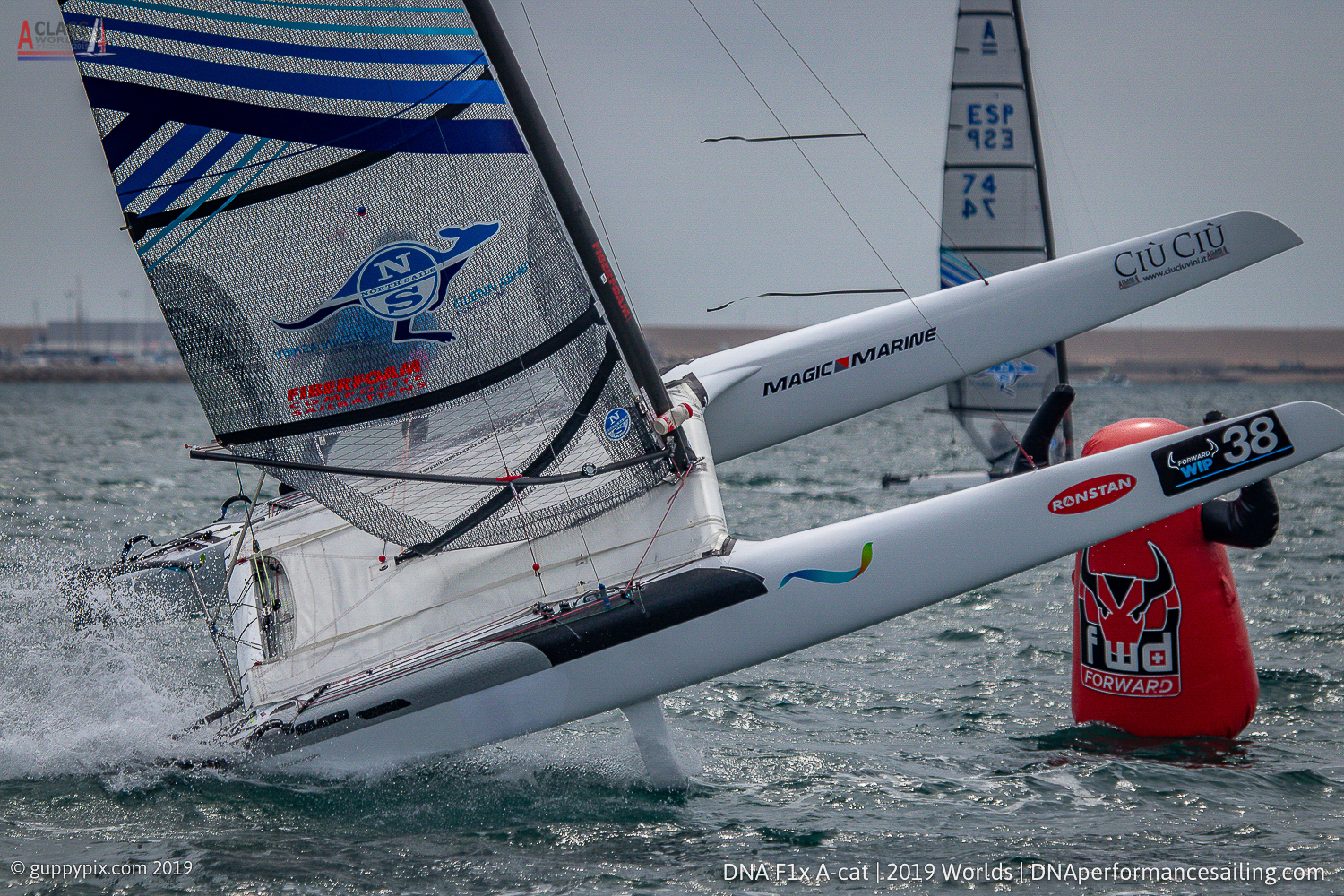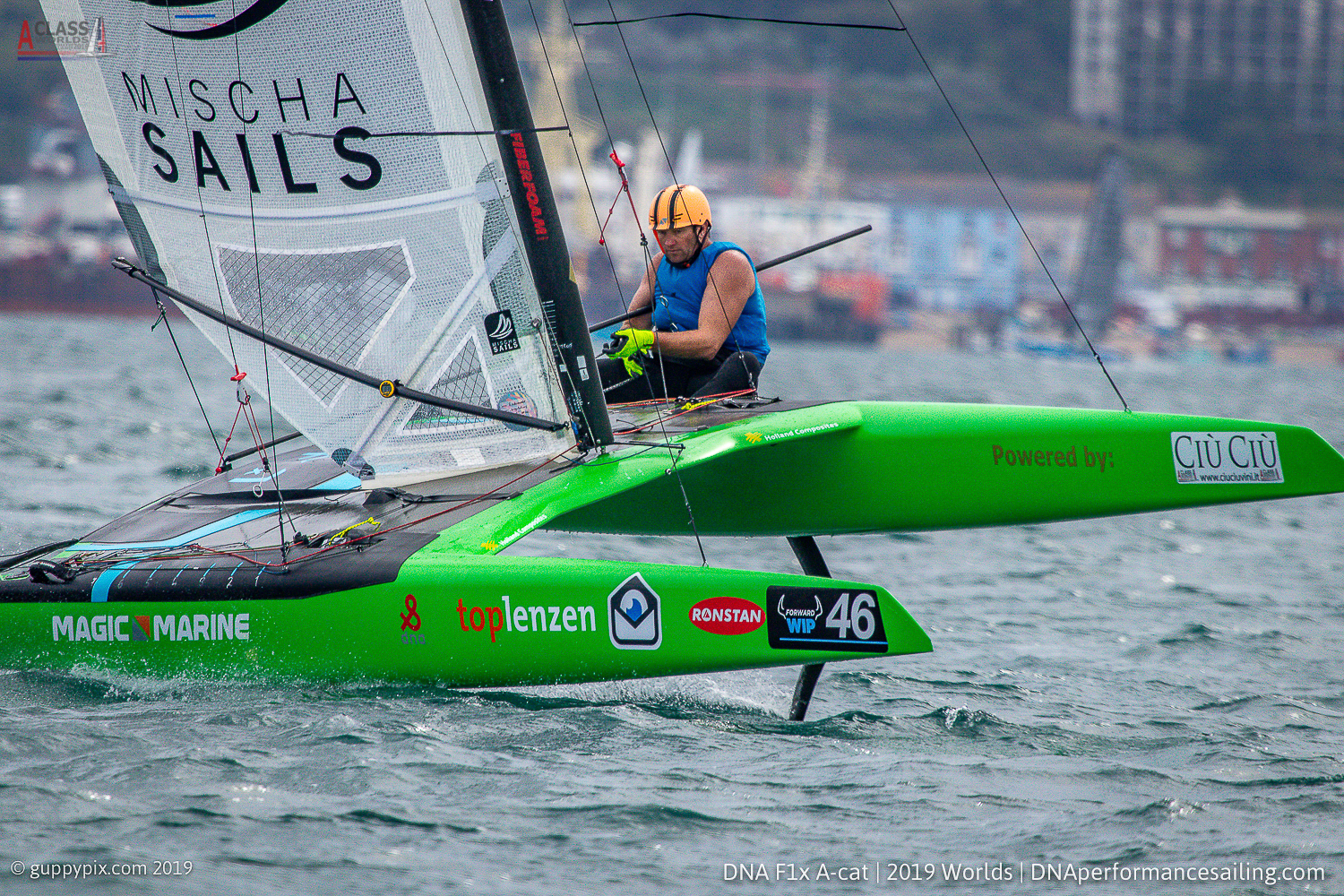Wednesday races and Weymouth delivers.
It was an early start for the Classic sailors at the World ‘A’ Cat Championships at WPNSA on Wednesday. The PRO, David Campbell-James, wanted to get them 2 races, before the Open fleet’s 3 later in the day, and a building wind was forecast. However, in the end the wind didn’t materialise quite as advertised, but they got a very sailable 8-10 knots, building slightly as the day progressed. This could be the first Worlds regatta that has completed the whole 12 race series for many years. But, then this is Weymouth, and one of the World’s top sailing event venues because of the wind conditions, associated sea states not to mention the facilities and event management, a true Olympic legacy. The sailors are starting to love it out there.
The Classics started both races cleanly, as ever, and found the left gave the best breeze, with extra puffs over on the far side nearer the big RN ships. Today was a day for the Old Imperial Guard to show them all how it was done and the father taught the son a few more tricks, as the former Champion Andrew Landenberger AUS 308 gave a masterclass to his 20 year old son Andy AUS 300, and also to the rest of the fleet by getting two bullets. The other places were fought over by another former Olympian and WC Scotty Anderson AUS 31, Alberto Farnesi SWE 59 and Enrique Cornejo ESP 5, all in the Grand Master and Great Grand Master catagories, proving there is still life in the old dogs yet. The Classic division is really starting to become a great way to have fun and a superb introduction to the class, without all the histrionics, screaming and that thousand yard stare that can occasionally be glimpsed in the eyes of the foiling sailors! And is thus ideal for the more ‘Mature’ sailors out there too.
Next on the bill were the Open foilers. They get released into the wild at the start of the last Classic race, so they can vacate the slipways and be in place in the start area as the Classics. It is a great working system and WPNSA have it organised down to a tee. After the last Classic finished, it was straight into setting up for the Open. Only minor course changes needed to be made before the sequence was started and they were off. About 11-12 knots is the windspeed for them to get really foiling upwind. This is the Holy Grail of ‘A’ Cat sailing and those who master it will easily add 25%+ to their speed. All the top half of the fleet at capable of at least some of this back art, resulting in quite a stretched field. Mischa Heemskerk NED 7, again was towards the front, as was Dave Shaw NZL 230, Manuel Calavia ESP 11 and Stevie Brewin AUS 4, all flying upwind a some 17-18 knots in the slowly building breeze. Reaching the top mark, they then all round off downhill again, after changing foil mode from the upwind settings to the more higher riding settings. They will shift position too, from just aft of the boards, to right on the back, as the centre of effort on the sail will change, tending to push the bows down, with the occasional hilarious consequence of a real crown pleaser of a full on pitch-pole. Steering to maintain the flight height and always easing and hailing in the mainsheet makes this a full on workout. The speed implications of a hull touching down can be as much as halving the boatspeed.
The bottom mark on many fleets can be an exciting place. On a foiling ‘A’ cat fleet in a decent breeze, it can be a proper spectator sport. Most boats, particularly with the wind as it was, were rounding the top mark and carrying on downwind until they reached their judged layline before banging in a gybe and hoping they had got the angles right. You probably have no more than 3 degrees to aim for from the distance at the gybe point, so unsurprisingly many got this slightly wrong. Too far downwind and you’ll need to sail higher into the mark. This can be a good thing as you can get some real high speeds at this finder angle. However, if you get a gust, you will need to bear away, taking you below your best course. Get it right, and you can gain many boat-lengths and positions. Several tended to end up too high, or had slight lulls requiring them to steer up a little to maintain foiling. They then usually needed a gybe back to get them to lay the mark, as you really don’t want to soak and sail deeper downwind in an ‘A’ Cat as you can haemorrhage positions if you do.
This gybe though, will then set them on the starboard tack, which is where the excitement comes from. Expensive 80kg carbon flying machines start crossing each other at closing speeds in excess of 30mph. The port boats then have to either crash gybe (may result in capsize), or luff up hast to cross behind (may result in capsize). Either way it is usually accompanied by much screaming of competitors. It is a testament to the skills of these sailors that no boats hit. And that was only the first lap. Twice more round again and then the stampede to the finish. No passing through the gate is needed then, so they just tend to eyeball it from that far gybe point. This is where the real close racing happens as sailors hurtle down onto the finish line at 27+ knots flying all the way. The first race was narrowly won by Mischa by about a boat-length from Manuel with Stevie half a length behind. Lower down the fleet, on their finishes similar dramas were played out and close finishes, fast splashdowns and capsizes on the line are frequent and keep the committee boat crew constantly entertained for which I’m sure they are very grateful.
Second race saw Stevie Brewin put the nose into the back of a wave and pitch-polled on the first downwind leg. He caught the top of his foot, probably on the shroud, as he flew off the boat forwards and the resulting cuts and grazing finished his regatta. This sort of injury is quite common on fast cats, and is something that is now being addressed by the top protective sailing clothing manufacturers. The race finished with another bullet for Mischa on the green monster with Dave Shaw about 100m behind and Kuba Surowiec POL 41 in third.
The final race of the day saw the wind click up a knot or so and the fleet set off for another 4 laps. Unfortunately, Bruce Mahoney USA 311 arrived at the start from the wrong side of the committee boat in the last minute, and picked up a UFD disqualification, which was particularly galling, as he sailed a hard race. By now the fleet was getting tired. Sailing these is like doing 50 mins of full on circuit training each race, and mistakes start being made. Mainsheets dropped, tacks and gybes messed up, jumping out on the trapeze starts to become tiring and for most in 15 knots tends to end with the boat on it’s side as a default. Again, Mischa won, but the finish for 2ndand 3rdwas close between Dave and Timuk Bendyk POL 15. Lower down again, boats who misjudged the gybe point had to gybe right in front of the committee boat, and on a few occasions forced crash gybes from other finishers, but again, no splintered carbon was heard.
All agreed it was a great day’s racing, and with 8 races now sailed they look forward to Thursday where they can improve their positions with luck.






